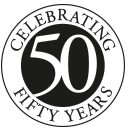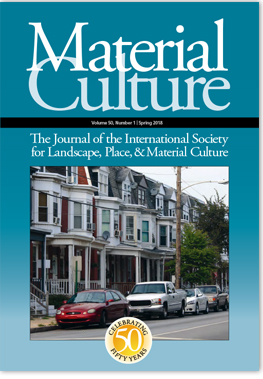 Material Culture is printed two times a year for members of ISLPMC. It is abstracted and indexed in: JSTOR, ProQuest, History and Life, Historical Abstracts, GeoAbstracts, and the MLA International Bibliography. You may download a PDF of the table of contents of the current issue here.
Material Culture is printed two times a year for members of ISLPMC. It is abstracted and indexed in: JSTOR, ProQuest, History and Life, Historical Abstracts, GeoAbstracts, and the MLA International Bibliography. You may download a PDF of the table of contents of the current issue here.
We normally include here the abstracts from the research articles that appear in the current issue, but because this issue celebrating our 50th anniversary is unique, we are instead reproducing the entire Letter from the Editor, which will give you the best overview of the Spring 2018 issue of Material Culture:

Dear Colleagues,
It is with great pleasure that I give to you the first of two issues of Material Culture that celebrate the journal’s 50th year of publication! While I am honored to be in the driver’s seat, if you will, for this celebration, I certainly cannot take credit for getting the journal to this point. Several people before me served this journal as its Editors; they solicited articles, coordinated peer review, provided content and copy editing, management of images, documents, and other records, occasionally delivered bad news, but often helped to extend people’s careers and disseminate knowledge about material culture and cultural studies. Without the steadfast dedication of my predecessors, the journal would not have reached its 50th year. A list of these individuals appears at the end of this note, as it is important to acknowledge that this anniversary is the result of tremendous work over time.
To mark this 50th anniversary publication of Material Culture, there are several special components to this issue, as well as other things that will appear in the second issue this year. First, I asked several leading, living scholars of material culture to contribute essays on their perspective of the field and the process of doing material culture research as it has changed over time. Two individuals accepted my invitation. The first is, very appropriately, a former editor of Material Culture, Simon J. Bronner. I connected immediately to Simon’s essay because I saw many similarities between his position at the time he became editor and mine a few decades later. We both assumed this position as newly-minted PhDs and (if I may be so presumptuous) both dealt with some feelings of insecurity as we assumed responsibility for editing the work of some very prominent scholars in the field while still infants in our academic careers. Simon is responsible for initiating the journal’s name change, and he reflects on this process in his essay.
Stan Brun was the second person to answer my invitation for reflective essays. Stan’s essay is less about material culture specifically and more about changing trends in human geography over time, as geographers have been one of the main disciplinary contributors to material culture studies in the United States. This broader, more discipline-wide perspective nicely complements Simon’s more focused look at our organization and journal in particular.
Next, I included reprints of two articles published in the first volume of Material Culture, which was called Pioneer America at the time, as many of you remember. I didn’t think a proper anniversary issue could exist without something from Henry Glassie, so his two-part article on the double-crib barn in South Central Pennsylvania appears here, along with an article on corner-timbering by Fred Kniffen.
The reprints are followed by a contemporary research article in the style reflective of the journal’s current image. This is an appropriate article for our anniversary issue, however, as it revisits both an idea and a region that were the focus of the journal’s early volumes. Ola Johannson and Michael Cornebise explore changes in the traditional urban form of four of Wilber Zelinsky’s original “Pennsylvania Towns” that he argued exhibited a different built environment from the rest of the United States. They use historical maps, field observations, online restaurant reviews, and census data as they compare Lancaster, York, Reading, and Harrisburg, Pennsylvania on demography, the built environment, and landscapes of consumption.
After the book reviews, which aren’t necessarily anniversary-focused, I left you with a little treat in the Final Take — a collage of the eight different cover styles that Material Culture has used over the last 50 years. As an aside, an analysis of cover design and imagery across all 50 years of issues is a research project worthy of consideration, if any of my readers ever find themselves alone in a desert of research ideas!
I enjoyed putting this special issue together, and I hope you enjoy reading it! Material culture scholars and enthusiasts have helped keep the journal and the Society alive, and we are grateful!
Sincerely,
Sara Beth Keough, Ph.D., Editor
